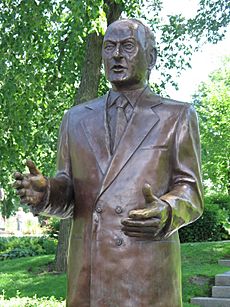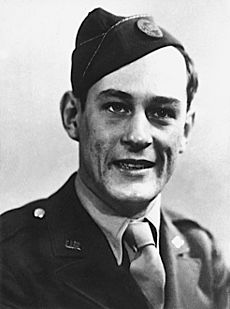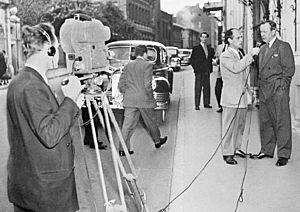René Lévesque facts for kids
Quick facts for kids
René Lévesque
|
|
|---|---|

Lévesque in 1961
|
|
| 23rd Premier of Quebec | |
| In office November 25, 1976 – October 3, 1985 |
|
| Monarch | Elizabeth II |
| Lieutenant Governor | Hugues Lapointe Jean-Pierre Côté Gilles Lamontagne |
| Deputy | Jacques-Yvan Morin Camille Laurin Marc-André Bédard |
| Preceded by | Robert Bourassa |
| Succeeded by | Pierre-Marc Johnson |
| Leader of the Parti Québécois | |
| In office October 14, 1968 – September 29, 1985 |
|
| Preceded by | Position established |
| Succeeded by | Pierre-Marc Johnson |
| Member of the National Assembly of Québec |
|
| In office June 22, 1960 – April 29, 1970 |
|
| Preceded by | Arsène Gagné |
| Succeeded by | André Marchand |
| Constituency | Montréal-Laurier (1960–66) Laurier (1966–1970) |
| In office November 15, 1976 – December 2, 1985 |
|
| Preceded by | Guy Leduc |
| Succeeded by | Claude Filion |
| Constituency | Taillon |
| Personal details | |
| Born | August 24, 1922 Campbellton, New Brunswick, Canada |
| Died | November 1, 1987 (aged 65) Montreal, Quebec, Canada |
| Cause of death | Heart attack |
| Political party |
|
| Spouses |
Louise L'Heureux
(m. 1947; div. 1978)Corinne Côté
(m. 1979) |
| Profession | Journalist |
| Military service | |
| Allegiance | United States |
| Branch/service | United States Army |
| Years of service | 1944–45 |
| Rank | Liaison officer |
| Battles/wars | World War II |
René Lévesque (born August 24, 1922 – died November 1, 1987) was an important Quebec politician and journalist. He served as the 23rd premier of Quebec from 1976 to 1985. He was the first Quebec leader since Confederation to try and make Quebec politically independent through a public vote (a referendum).
Lévesque started his career as a reporter and host on radio and TV. He became well-known for his key role in making electricity companies in Quebec public, which is called nationalization of hydro. He was also a strong supporter of Quebec sovereignty, meaning Quebec becoming its own country. He founded the Parti Québécois, a political party focused on this idea. Before that, he was a minister in the Liberal government from 1960 to 1966.
Contents
Early Life and Education
Lévesque was born in Campbellton, New Brunswick, on August 24, 1922. He grew up in New Carlisle, Quebec, on the Gaspé Peninsula. His parents were Diane and Dominic Lévesque, who was a lawyer. René had three siblings: André, Fernand, and Alice. His father passed away when René was 14 years old.
René Lévesque went to school at the Séminaire de Gaspé and the Saint-Charles-Garnier College in Quebec City. Both schools were run by the Jesuits. He later studied law at Université Laval in Quebec City but left in 1943 before finishing his degree.
Career as a Journalist
Lévesque worked as an announcer and news writer for radio stations like CHNC and CBV in Quebec City.
During 1944–1945, he worked as a war correspondent for the U.S. Army in Europe. He reported from London while it was being bombed. He moved with the Allied troops as they pushed back the German army. He sent regular reports on radio and in newspapers. He was with the first American unit to reach the Dachau concentration camp.
In 1947, he married Louise L'Heureux. They had two sons and a daughter. Lévesque then worked as a reporter for the CBC's French section. He also reported from the Korean War in 1952. After this, he chose to stay in Canada even though he was offered a job in the United States.
From 1956 to 1959, Lévesque became very famous in Quebec. He hosted a weekly TV news show on Radio-Canada called Point de Mire.
He covered big international events and important labour strikes. These strikes involved workers and companies, especially during the time of Premier Maurice Duplessis's government. One major strike was at the Gaspé Copper Mine in Murdochville in 1957. This strike was a big moment for workers' rights in Quebec and led to changes in the province's labour laws.
While working for the public TV network, he got involved in a strike by broadcasters. It lasted 68 days starting in late 1958. Lévesque was arrested during a protest in 1959.
Entering Politics
Liberal Cabinet Minister
In 1960, Lévesque decided to enter politics. He was elected to the Legislative Assembly of Quebec in the 1960 election. He was a member of the Liberal Party for the area of Montréal-Laurier. In the government led by Jean Lesage, he held important roles.
He was the minister of hydroelectric resources and public works from 1960 to 1961. Then he became the minister of natural resources from 1961 to 1965. During this time, he played a key part in making hydroelectric companies public. This greatly expanded Hydro-Québec. This was a major change during the Quiet Revolution in Quebec.
From 1965 to 1966, he was the minister of family and welfare. Lévesque worked with Eric Kierans, the health minister, to talk with the Canadian government. They discussed funding for social programs in Quebec.
The Liberals lost the 1966 election. However, Lévesque kept his seat in Laurier. He started to believe that Canada's system was not working for Quebec. He began to openly support Quebec separating from Canada. This idea was discussed within the Liberal party. The idea was voted down, and Lévesque left the party with his supporters.
Founding the Parti Québécois
After leaving the Liberal Party, Lévesque started a new group called the Mouvement Souveraineté-Association (MSA). This group was different from other nationalist movements. It focused on appealing to regular people, not just activists. Lévesque strongly believed that English schools and language rights in Quebec should be protected.
In 1968, the MSA joined with another party, the Ralliement National. Together, they created the Parti Québécois (PQ). Lévesque insisted that members from other groups could join individually.
In the 1970 election, the Parti Québécois got 25 percent of the votes. They promised to declare independence if they formed the government. However, the PQ only won six seats. Lévesque continued to lead the party from Montreal.
The 1973 election resulted in a big win for the Liberals. This caused problems within the PQ, especially after Lévesque did not win a seat.
Premier of Quebec (1976–1985)
Lévesque and his party won a huge victory in the 1976 election. Lévesque finally won a seat in the Assembly for Taillon. His party took power with 41.1 percent of the votes and 71 out of 110 seats. They even defeated the sitting Premier, Robert Bourassa, in his own area. Lévesque became Premier of Quebec ten days later. On the night of his victory speech, he famously said, "I never thought that I could be so proud to be Québécois."
Protecting the French Language
A major achievement of his government was the Quebec Charter of the French Language. This law is also known as Bill 101. Its main goal was to make French "the normal and everyday language of work, instruction, communication, commerce and business."
The law stated that only children whose parents had gone to English school in Quebec could attend English public schools. All other children had to go to French schools. This was to help immigrants become part of the French-speaking culture. Bill 101 also made it illegal for businesses to have outdoor signs in a language other than French. At that time, English signs were very common in Quebec.
Quebec's Future
Lévesque wanted Quebec to have more control over its future. On May 20, 1980, the PQ held a 1980 Quebec referendum as they had promised. This vote was about their plan for Quebec to have "sovereignty-association." This meant Quebec would be sovereign (independent) but still have an economic partnership with Canada. The result was 40 percent in favour and 60 percent against. Lévesque accepted the defeat, saying he understood the message: "until next time."
Lévesque led the PQ to another victory in the 1981 election. The party won more seats and increased its share of the popular vote.
A big focus of his second term was the patriation of the Canadian constitution. This meant bringing Canada's constitution fully under Canadian control from Britain. Lévesque was criticized by some in Quebec. They felt he had been outsmarted by Canadian Prime Minister Pierre Trudeau and other provincial leaders. Even today, no Quebec premier has fully supported the 1982 constitutional changes.
Other Important Changes
On February 6, 1977, Lévesque was involved in a car accident where a man lying on the road was killed. Lévesque was later fined for not wearing his glasses while driving. His marriage ended, and he later married Corinne Côté in April 1979.
Lévesque's government finished making all hydroelectric companies public under Hydro-Québec. He also created the Quebec Charter of the French Language. His government was the first in Canada to ban discrimination based on sexual orientation in 1977. He also continued to improve social services. This meant the government, not the Catholic Church, took care of social needs. Many people still see Lévesque as a symbol of democracy and fairness.
The PQ government had to cut the provincial budget in the early 1980s because of a recession. This angered labour unions, who were strong supporters of the PQ.
Lévesque's law about financing political parties banned donations from companies. It also limited how much individuals could donate. This was to stop rich people and groups from having too much influence on elections. A Referendum Act was also passed. This law made sure that both the "yes" and "no" sides in a province-wide vote got equal funding and legal standing.
Resignation
Lévesque believed the party should not make sovereignty the main issue in the 1985 election. Instead, he wanted to try a "Beau risque" (beautiful risk) strategy. This meant trying to find an agreement with the federal government led by Brian Mulroney. This idea angered many strong supporters of sovereignty within his party. He said the next election would not be about sovereignty. He hoped they could find leaders in Ottawa who would discuss Quebec's needs seriously. This new stance weakened his position. Some senior members resigned, and the party lost some by-elections. Lévesque resigned as leader of the Parti Québécois on June 20, 1985. He stepped down as Premier of Quebec on October 3, 1985.
Retirement and Death
Lévesque was a constant smoker. On November 1, 1987, he was hosting a dinner party when he felt chest pains. He died of a heart attack that night at Montreal General Hospital. After his death, there was a brief increase in support for Quebec independence. Over 100,000 people saw his body lying in state in Montreal and Quebec City. More than 10,000 attended his funeral in Quebec City.
Lévesque was given the high honour of Grand Officer of the French Legion of Honour. He was also posthumously made a Grand Officer of the National Order of Quebec in 2008.
René Lévesque's Legacy

Even though some thought his desire for sovereignty weakened later in his career, Lévesque confirmed his belief in independence to friends and students before his death.
His state funeral was attended by 100,000 Quebecers. As his coffin was carried out, the crowd began to sing Quebec's unofficial anthem, "Gens du pays". They changed the first line to Mon cher René (My dear René). Two major boulevards are now named after him: one in Montreal and one in Quebec City. In Montreal, the Hydro-Québec building and the Maison Radio-Canada are on René Lévesque Boulevard. This is fitting because Lévesque worked for Hydro-Québec and the CBC. In 2010, the 1244-megawatt Manic-3 generating station was renamed in his honour.
On June 3, 1999, a monument was put up in his honour outside the Parliament Building in Quebec City. The statue is popular with tourists. They often take pictures "avec René" (with René). The statue's fingers are slightly open, and people used to put cigarettes in them, making it look very real.
This practice is less common now because the statue was moved and replaced by a similar, but larger one. Some people felt the original life-sized statue was not grand enough for his importance. Others noted that Lévesque was known for his relatively small height.
Today, Lévesque remains a very important figure in the Quebec nationalist movement. He is seen as the spiritual father of Quebec sovereigntism. After his death, even those who disagreed with his political views generally recognize his importance to the history of Quebec. Many in Quebec see him as the father of the modern Quebec nation. A 2006 study found that Quebecers considered Lévesque the best premier of the province in the last 50 years.
René Lévesque has been portrayed in TV series and even a Canadian cartoon show. A song by the band Les Cowboys Fringants called "Lettre à Lévesque" is dedicated to him. He was also the subject of a documentary miniseries called The Champions, along with Pierre Trudeau.
Personality and Interests
Lévesque was known for being charming and tactful. But he could also be quick to anger when defending his beliefs or if he felt disrespected. He was proud to be a Gaspésien (from the Gaspé Peninsula) and had a slight local accent.
He was seen as a major defender of Quebecers. Before the 1960s, he was more interested in international news than in Quebec politics. People often remember Lévesque for his constant cigarette and his small height. He also had a unique comb over hairstyle, which earned him the nickname "Ti-Poil" (meaning "Li'l Hair" or "Baldy"). Lévesque was a very passionate and emotional public speaker. However, those close to him said he found it hard to show his emotions in private. He was more comfortable speaking to thousands of people than to just one person.
While many Quebec thinkers were inspired by French culture, Lévesque preferred the United States. He spoke fluent English and regularly read The New York Times. He also took his vacations in New England every year. He once said that if he had a role model, it would be U.S. President Franklin Delano Roosevelt. During World War II, he admired the courage of Britons when he saw them face German bombings in London.
Images for kids
See also
 In Spanish: René Lévesque para niños
In Spanish: René Lévesque para niños
- List of Gaspésiens
- List of premiers of Quebec
- List of Quebec general elections
- Politician nicknaming in Quebec
- Politics of Quebec
- Separatism




